Ed Gorman's Blog, page 93
April 26, 2014
Forgotten Books: The great John Farris
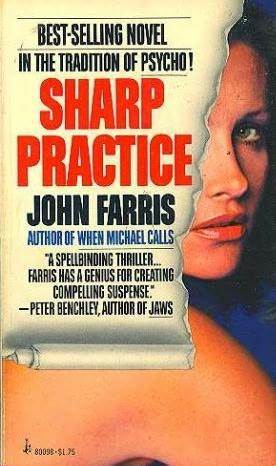
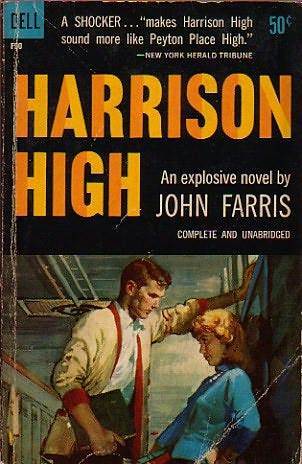
Let’s see. Sharp Practice by John Farris is a slasher novel. And it’s also a police procedural of a very British kind (though written by an American). A love story (the long-suffering wife of a cheating husband; the brother and sister who just can’t keep their hands off each other; numerous people lonely and neurotic in very modern ways). A gentle spoof of the hierarchy of academia. A look at the frustrations of a writer trying come up with another novel And of course a look at one of the most savage murderers in modern suspense fiction, though Farris is wise enough not to give us an autopsy. He’s Hithcockian in his belief that less is more. Praise the Lord.
And that’s just a partial list of the novel's elements.
It is also one of the most sophisticated, elegantly told and perverse novels of terror ever written. The surprises are so stunning that two or three times I had to put the book aside and take a little rest. There are three twists in this novel that are so cunningly wrought they will shock even the most jaded reader.
That’s all I’m going to say about Sharp Practice. Read it and you’ll see that I’ve understated my enthusiasm for its suave brilliance.
So instead of a book report I’d like to turn to Mr. Farris himself.
Here's a quote from Steve Lewis that introduces Farris very well:
"It has just occurred to me that John Farris has one of the longest careers of any mystery writer still active. His first novel, The Corpse Next Door, was published by Graphic Books, a small but solid line of mostly paperback originals, in 1956. Farris was born in 1936, so if the book wasn’t published until he was 20, the odds are the most of it was written when he was still nineteen.
"He switched to the pen name of Steve Brackeen for his next few books, typical Gold Medal thrillers, except that Gold Medal didn’t do them. One of them, Baby Moll (Crest, 1958), will be reprinted by Hard Case Crime later this year under his own name, a mere 50 years later.
" Farris eventually became the author of the “Harrison High” books, which sold in the millions, and he became an even bigger seller once he started writing horror fiction that was invariably tinged with the supernatural. Books like The Fury (1976) and All Heads Turn When the Hunt Goes (1977) are as close to classics in the field as you’re going to get, and yet … even though Farris has averaged close to a book a year since those two books, unlike Stephen King, Dean R. Koontz and mystery-wise, Ed McBain, who came along about the same time he did, it is as if no one’s ever heard of him. Nobody knows his name."
If you were a reader in the early 1960s it was impossible not to know the name of John Farris. Harrison High, the novel Lewis refers to, was popular for two reasons. First because it was a fine true novel about high school life. The aspects that were judged scandalous by some critics were in fact the truest parts of the book.
What set it apart from all the other high school novels was that it was very much like the literary novels of the time, especially those of the unjustly forgotten Calder Willingham. Harrison High remains rich in dealing with its era (the late 1950s), its people (generally middle-class whites) and its social problems (back alley abortions were still common). But with all that it's the characters I've kept with me. And having gone back to the novel several times over the years I'm aware of how carefully and honestly Farris drew them.
The second reason for the book's popularity was that it was written by an ambitious young man who wasn't long out of high school himself. The Dell paperback edtion (much like Peyton Place just before it) seemed to be everywhere. Farris' photo on the back cover depicted a thoughtful man who might have played football at one time or another.
John Farris went on to write many more novels, a number of them true and lasting masterpieces. But for people my age that thick Dell paperback version of Harrison High was an especially important novel.POSTED BY ED GORMAN AT 1:59 PM

Published on April 26, 2014 19:07
April 22, 2014
HELP WITH YAHOO
I've been unable to get on to my Yahoo account for two and a half weeks. I try to create a new password (something I'm forced to do every other time I've tried to connect) but now Yahoo sends the form to an old address I no longer have. Getting them on the phone is impossible. I've even tried my computer service and they can't figure it out either.
Published on April 22, 2014 05:30
April 20, 2014
Lawrence Block's Borderline from Hard Case Crime spelling corrected
[image error]
[image error]
[image error]
[image error]
A long time ago I said that Lawrence Block writes the best sentences in the business. I don't see any reason to change my mind.
Take the example of this nineteen fifty eight soft core novel Borderline now available from Hard Case Crime. In addition to the pleasure of reading sentences that sing, stomp and strut, there is the considerable heft of the story itself. If this was dashed off, as many of soft cores were, this is one of the finest dashing offs ever put to paper. In structure it reminds me of the novels John D. MacDonald was writing as originals for Gold Medal. A large cast of characters meeting in likely and unlikely ways (this time on the Texas-Mexican border) hurtling toward an explosion that will change them forever. Talk about your page turner. I read this, something I rarely do, in a single sitting just because of its bitter and brutal force. (Three short stories fill out the book.) How's this for a ship of fools? A conflicted and troubled gambler named Marty. A psychopath named Weaver who has just learned how much he likes to kill women. A nineteen year old victim of rape and desperation named Lily who turns to prostitution. A bi-sexual hooker, Cassie, who sets her sight on Lily. And there are numerous other characters who lend a hand in making this a bleak but surprisingly rich novel. We'll see all these characters again in future and better Block novels. Here he is in the business of beginning to populate Block World and speak in Block Voice. He will go on to expand every element of this novel in theme, tone and pure storytelling. More than in any other of the Block soft cores I've read (and I've enjoyed every single one of them) here you see a great writer busy creating a realm exclusively his own.
[image error]
[image error]
[image error]
A long time ago I said that Lawrence Block writes the best sentences in the business. I don't see any reason to change my mind.
Take the example of this nineteen fifty eight soft core novel Borderline now available from Hard Case Crime. In addition to the pleasure of reading sentences that sing, stomp and strut, there is the considerable heft of the story itself. If this was dashed off, as many of soft cores were, this is one of the finest dashing offs ever put to paper. In structure it reminds me of the novels John D. MacDonald was writing as originals for Gold Medal. A large cast of characters meeting in likely and unlikely ways (this time on the Texas-Mexican border) hurtling toward an explosion that will change them forever. Talk about your page turner. I read this, something I rarely do, in a single sitting just because of its bitter and brutal force. (Three short stories fill out the book.) How's this for a ship of fools? A conflicted and troubled gambler named Marty. A psychopath named Weaver who has just learned how much he likes to kill women. A nineteen year old victim of rape and desperation named Lily who turns to prostitution. A bi-sexual hooker, Cassie, who sets her sight on Lily. And there are numerous other characters who lend a hand in making this a bleak but surprisingly rich novel. We'll see all these characters again in future and better Block novels. Here he is in the business of beginning to populate Block World and speak in Block Voice. He will go on to expand every element of this novel in theme, tone and pure storytelling. More than in any other of the Block soft cores I've read (and I've enjoyed every single one of them) here you see a great writer busy creating a realm exclusively his own.
Published on April 20, 2014 08:06
Lawrence Block's Borderline from Hard Case Crime
[image error]
A long time ago I said that Lawrence Block writes the best sentences in the business. I don't see any reason to change my mind. Take the example of this nineteen fifty eight soft core novel Borderline now available from Hard Case Crime. In addition to the pleasure of reading sentences that sing, stomp and strut, there is the considerable heft of the story itself. If this was dashed off, as many of soft cores were, this is one of the finest dashing offs ever put to paper. In structure it reminds me of the novels John D. MacDonald was writing as originals for Gold Medal. A large cast of characters meeting in likely and unlikely ways (this time on the Texas-Mexican border) hurtling toward an explosion that will change them forever. Talk about your page turner. I read this, something I rarely do, in a single sitting just because of its bitter and brutal force. (Three short stories fill out the book.) How's this for a ship of fools? A conflicted and troubled gambler named Marty. A psychopath named Weaver who has just learned how much he likes to kill women. A nineteen year old victim of rape and desperation named LIly who turns to prostitution. A bi-sexual hooker, Cassie, who sets her sight on Lily. And there are numerous other characters who lend a hand in making this a bleak but surprisingly rich novel. We'll see all these characters again in future and better Bloch novels. Here he is in the business of beginning to populate Bloch World and speak in Bloch Voice. He will go on to expand every element of this novel in theme, tone and pure storytelling. More than in any other of the Bloch soft cores I've read (and I've enjoyed every single one of them) here you see a great writer busy creating a realm exclusively his own.
A long time ago I said that Lawrence Block writes the best sentences in the business. I don't see any reason to change my mind. Take the example of this nineteen fifty eight soft core novel Borderline now available from Hard Case Crime. In addition to the pleasure of reading sentences that sing, stomp and strut, there is the considerable heft of the story itself. If this was dashed off, as many of soft cores were, this is one of the finest dashing offs ever put to paper. In structure it reminds me of the novels John D. MacDonald was writing as originals for Gold Medal. A large cast of characters meeting in likely and unlikely ways (this time on the Texas-Mexican border) hurtling toward an explosion that will change them forever. Talk about your page turner. I read this, something I rarely do, in a single sitting just because of its bitter and brutal force. (Three short stories fill out the book.) How's this for a ship of fools? A conflicted and troubled gambler named Marty. A psychopath named Weaver who has just learned how much he likes to kill women. A nineteen year old victim of rape and desperation named LIly who turns to prostitution. A bi-sexual hooker, Cassie, who sets her sight on Lily. And there are numerous other characters who lend a hand in making this a bleak but surprisingly rich novel. We'll see all these characters again in future and better Bloch novels. Here he is in the business of beginning to populate Bloch World and speak in Bloch Voice. He will go on to expand every element of this novel in theme, tone and pure storytelling. More than in any other of the Bloch soft cores I've read (and I've enjoyed every single one of them) here you see a great writer busy creating a realm exclusively his own.
Published on April 20, 2014 08:06
April 19, 2014
Gravetapping-Thrift Shop Book Covers: Just Before Dark by Jack MacLane aka Bill Crider
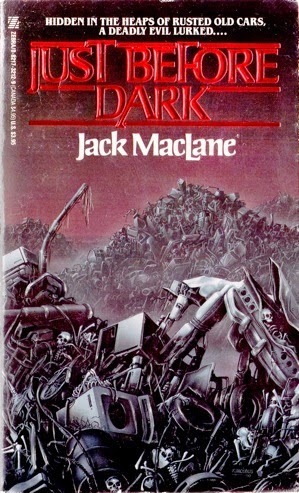
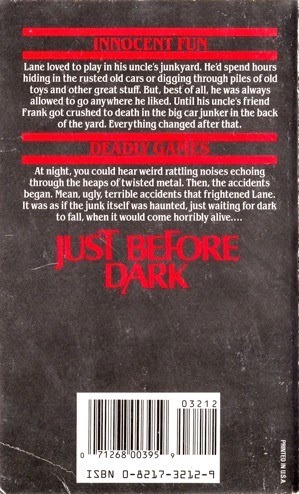
From Ben Bouden GRAVETAPPINGPosted: 17 Apr 2014 02:16 PM PDTJust Before Dark is the fifth (of five) horror novels written by Bill Crider and published as by Jack MacLane. It was published by Zebra in November 1990, and the cover art is terrific in a disturbing if tongue-in-cheek sort of way. It is dark—a purple smudge for sky—and features a cold metallic junkyard piled high. It reminds me of the first thirty minutes of the film “Wall-E” with the added appeal of skeletons strewn throughout. The artist is uncredited.
The opening paragraph:
“Frank Castella remembered dying.”
I haven’t read any of the “Jack MacLane” novels, but knowing the general high quality of Mr Crider’s work I plan to remedy that very soon. All five of the MacLane novels are currently available as ebooks.
This is the fifth in a new series of posts featuring cover and miscellany of books I find at thrift stores and used bookshops. It is reserved for books I purchased as much for the coer art as for the story or author.

Published on April 19, 2014 10:58
April 18, 2014
Paul De Filippo discusses Robert Moore Williams and minor writerdom
This is from Locus Science Fiction Paul Di Filippo has written some of my favorite contemporary science fiction. Here he takes a look at a truly forgotten writer and not only assesses his work but also talks about the fate and relevancy of those minor writers.I read a lot of Robert Moore Williams in my early teens. Here Di Filippo gives him an honest and honorable overview. Paul De Filippo:
If we regard the world of literature and publishing as a forest ecosystem, then somebody has to be the mulch, the humus, the duff. It’s not a glamorous role. You’re not a giant sequoia or even a pretty little mountain laurel shrub. You’re the compost, the soil that supports everything else. Humble, overlooked, but essential.Okay, maybe that metaphor can be stretched to the snapping point. But still, that near-anonymous supportive functionality is always how I think of a certain tier of writers. They had long, productive careers, selling books, providing mild pleasure to many readers, somehow serving as a foil to the luminaries of the genre. Taken together, they were the substrate of competence on which the masters flourished. You can’t have a genre composed of one-hundred-percent geniuses, simply because there aren’t enough geniuses to go around. Modern commerce and the recreational demands of consumers mean there has to be a pipeline full of decent but nearly interchangeable product all the time.But guess what? Sometimes reading these humus authors delivers a certain kind of modest, unique pleasure otherwise unobtainable. With them, you don’t confront the pressure of being worthy of their masterpieces. They labored in quiet and without expectations or constraints, rewarded so long as they delivered on time. Occasionally their work bordered on the surprising, and even the brilliant. Also, after enough time has passed, their work evokes a greater nostalgia, because it is generally timebound, a distinctive product of the era, rather than some timeless, transcendent work of genius.By any standard, the forgotten Robert Moore Williams was one such figure. Here’s what the Science Fiction Encyclopedia has to say about him . “[By] the 1960s [he] had published over 150 stories. Though most are unremarkable, he was an important supplier of competent genre fiction during these decades, and tales like “Robot’s Return” (September 1938 Astounding)…retain a dawn pathos.”If you want to sample Williams’s work in a very handy and attractive format, you should pick up the new collection from Armchair Fiction, a fine firm that specializes in reprints of neglected writers, as well as lesser-known items from the famous.I’ll put the original sources for these tales in parentheses. The litany of old zines is potent in itself.The volume opens strongly with “Time Tolls for Toro” (Amazing, 1950). Right from the start we sense that Williams can command an emotional immediacy and impact which overcomes his often blunt prose and erratic plotting. A man is walking down a city street in a kind of automatic fugue state, unknowing of his own identity or much else. Williams gives us a red herring, with news that police are looking for an escaped killer named Toro. Is this our hero? But no, he proves to be William Sumner, the inventor of time travel. We also get a beautiful mystery woman, and the eventual appearance of Toro, who proves to have surprises of his own. There’re kidnappings and cloak and dagger stuff and a gruesome set piece of mass murder by Toro, and then everything is resolved rather matter-of-factly. Endings were not Williams’s strong suit. But while the van Vogtian or Phildickian confusion is ongoing, it’s marvelous.for the rest go here:http://www.locusmag.com/Reviews/2014/...
Published on April 18, 2014 10:31
April 17, 2014
Forgotten Books: Cross Country by Herbert Kastle
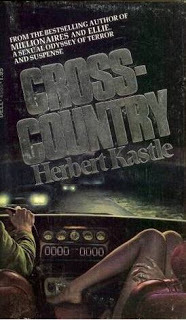
Forgotten Books: Cross Country by Herbert Kastle
FORGOTTEN BOOKS: CROSS COUNTRYHerbert D. Kastle wrote a number of science fiction stories in magazines of the 1950s. That's where I first read him. Later in the 1960s he was writing those fat sexy bestseller-type novels that owed more to marketing and Harold Robbins than his presumed muse. Then in 1974 he wrote CROSS COUNTRY. Here's a quote from one of the reviews: "This novel seems to occupy the same dark and twisted territory as the works of Jim Thompson. Characters interact in a dance of barely suppressed psychopathological urges and desires that is as grotesquely fascinating as a multi-car pileup on the freeway. It may leave you feeling unclean afterwards, but chances are you will not forget it."
Damn straight. It really is a sewer of sex and terror and blood-soaked suspense. I read it in one long sitting. If it's trash, as some called it at the time, it is spellbinding trash.
IMDB sums up the story line succintly: "After a woman is found butchered in her New York apartment, suspicion falls on her estranged husband, an ad executive who has suddenly left town on a cross-country road trip. He takes along a beautiful girl he met in a bar and a drifter he picked up along the way. A cop sets out after the husband, but he's more interested in shaking him down than bringing him back."
Kastle masterfully controls his long nightmare journey and you buy into his paranoia. He shows you an American wasteland of truck stops, motels, convenience stores connected by interstate highway and darkness. By book's end everyone will betray everyone else. This is survival of the fittest enacted by a Yuppie businessman, sociopathic hippies and a crooked cop. The sheer nastiness of Kastle's existential vision make this book impossible to forget. Thirty-some years after I first read it I still think of it from time to time when hundreds of other novels have fled from memory.
It's a vision of hell that fascinates you as it troubles your conscience.
Published on April 17, 2014 11:20
April 16, 2014
Forgotten Films: The Man From Laramie
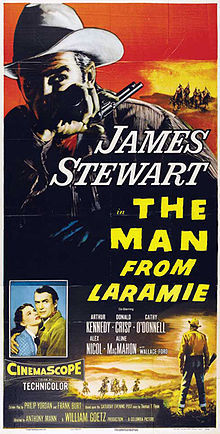
The Man From LaramieTCM ran the letterbox version of The Man From Laramie this afternoon. I hadn't seen it in years and I'll tell you I was dazzled by it in every respect. If, as John D. MacDonald suggested, most pulp fiction is actually a kind of folk tale, then Laramie is one of the best folk tales ever told.
I've never heard a satisfactory explanation from why Anthony Mann and James Stewart fell out. But what an extraordinary way to say goodbye.
While Stewart is the star this is really ensemble acting. In fact Donald Crisp as the complicated, doomed patriarch is, for me, the most compelling character in the movie.
If I was asked to compare the differences between a genre western (even a great one) and a mainstream western I'd point to this film. Each of the main characters has a history that bears at length on the story. Stewart, as usual in a Mann western, is driven by a hatred that makes him difficult to like at certain time, though the violence visited on him early on still has the ability to shock even in this age of slice and dice movies. A great line early is spoken by an old man to Stewar:t "Hate is unbecoming on some men, Mr. Lockhart. On some men it shows."
For me, Mann is a far better director of westerns than John Ford (though I greatly admire The Searchers and The Man Who Shot Liberty Valance). There is no sentimentality or Cavalry myth here. There a few scenes that would do the Sopranos proud.
Laramie is also one of the most exciting hardboiled stories ever done in the western field. Phillip Yordan's fine script gives us a twist every fifteen minutes or so. And the last twenty minutes consist of three stunning set-pieces of sustained action.
And what a pleasure to see Cathy O'Donnell again. A sad, quiet turn here gives a look at how limited life was for women on the frontier.
Here's a good over view from IMDB:
Author: ironside (robertfrangie@hotmail.com) from Mexico
Some of the best Westerns of the fifties were those directed by Anthony Mann and John Ford, straightforward and unpretentious, but each with an interesting approach to the requirements of the genre... Mann's films were the more prestigious, usually featuring James Stewart who, with John Wayne, was the fifties' biggest box-office draw... "The Man From Laramie" best known because of the Frankie Laine theme strong which accompanied it, is notable for (among other things) Alex Nicol's extraordinary projection of sadism, an element which dominated the best of Mann's movies... The motion picture was to be the last of the Mann-Stewart Westerns...
Stewart is cast as a wagon handler from Laramie, Wyoming, but is, really, an army officer out to avenge the death of his younger brother, a U.S. Cavalryman, massacred by the Apaches who were buying guns from unknown persons... It is these persons that Stewart is looking for..
Soon Stewart gets involved in an area of New Mexico which is ruled by the iron hand of a cattle baron Donald Crisp, a strong authoritarian "who can't live with a lie"... Crisp's one weakness is his love and care for his spoiled son, Alex Nicol...
Wild but feeble, yet vicious, Nicol - with extraordinary projection of sadism - accosts Stewart in several confrontations in which (among other outrages) Stewart is dragged through fire by horses, and has his hand held tight while Alex puts a bullet through it... Mann proceeds in this mood throughout the movie, growing even more sadistic...
Arthur Kennedy, a hard-working heavy, plays the adopted son of Crisp... He is a son in disguise, jealous of Alex, pretending to be his brother's ally and protector...
A lot of good supporting actors are cast including Cathy O'Donnell, the fragile beauty who has little to do but await patiently for an opportunity; Aline MacMahon, the fine 'ugly' woman who never leaves the old man, and Jack Elam who tries to knife James Stewart in the back...
Anthony Mann adopted an altogether tougher approach to Western mythology than John Ford... His obsessive, neurotic characters and his emphasis on violence foretell the work of Peckinpah, Leone and Eastwood...
Filmed in Technicolor, "The Man From Laramie" is a Western with new touches of brutality touching off the wide screen spectacle...
Published on April 16, 2014 14:40
April 15, 2014
TV NEWS The Final Season of 'Justified' Must Get Back to the 'Core 3'

by Michael Griffin Hollywood.comThe final scene of the fifth season of Justified ended as it began: at night, with a Crowder on the Harlan County bridge that has played home to so many illicit activities. This time, it was Ava Crowder (Joelle Carter), and she was there for an task that surely ate at her soul — being a CI for Raylan Givens (Timothy Olyphant). It was Givens who was able to pull her out of her predicament at the penitentiary and he wanted her to show her gratitude by gathering information to help the Marshal's Office put away Boyd for at least the next 50 years.With that sequence of events, the show left us no room for error for what will transpire in the final season. Boyd, who has already had a number of bad guys out gunning for him, is going to be feeling the squeeze of the law. And that group will be led by Givens, who used to work in the mines with Boyd a lifetime ago, before the two went on very, very divergent paths. This would likely put an end to the occasional alliance that exists between the two and will probably have Boyd reconsidering his decision in the second season to save Raylan from being whacked open like a pinata by Dickie Bennett (Jeremy Davies).If they are smart (and Graham Yost and his crew have proven themselves to be near Mensa-level geniuses at crafting some of the most compelling television out there), the showrunners will spend the final season of Justified back in the hands of the Core 3: Givens, Ava and Boyd — the meat of the show from its early days.There have overarching villains in nearly every season of Justified but the first. The only villain needed for this final go-'round is Boyd. That way, the focus can be on those central characters, relegating some other favorites to satellite roles (like Rachel Brooks and Tim Gutterson), the likes of Wynn Duffy and Katherine Hale to occasional components of the story, and the newly retired Art Mullen to a cameo appearance or two. We might even go so far as to predict (or hope) that the final scene of the show somehow emulates the last moments of the pilot, with Raylan shooting Boyd, but this time, with no reprieve. (For those who don't know, Boyd was supposed to die in that pilot, like he did in the short story "Fire In The Hole." However, Walton Goggins blew everyone away with his performance and was granted a starring part.) However the series ends, it needs to come right down to the relationship that made the program so compelling in the first place. This is a show about Raylan and his toxic roots, and nobody better exemplifies those roots than Boyd.
Published on April 15, 2014 13:48
April 14, 2014
The Onion Field Novel & Movie
 Ed here: For me one of the most important books I've ever read. And the movie is almost as good as the book.
Ed here: For me one of the most important books I've ever read. And the movie is almost as good as the book.by Greg Ferrara Movie MorlocksTHE ONION FIELD, 35 YEARS LATER
 Posted by gregferrara on April 13, 2014There was a time in the seventies when Joseph Wambaugh was just about the top crime writer in the nation. In the years before John Grisham and James Patterson came to prominence, Wambaugh novels got multiple adaptations into film but, unlike Grisham and Patterson, they weren’t very successful at the box office although they were very good on the whole and one of them, The Onion Field, scored big both with audiences and critics and launched the career of James Woods. I hadn’t seen it since 1979 and was surprised upon a second viewing how much better it was than I remembered.
Posted by gregferrara on April 13, 2014There was a time in the seventies when Joseph Wambaugh was just about the top crime writer in the nation. In the years before John Grisham and James Patterson came to prominence, Wambaugh novels got multiple adaptations into film but, unlike Grisham and Patterson, they weren’t very successful at the box office although they were very good on the whole and one of them, The Onion Field, scored big both with audiences and critics and launched the career of James Woods. I hadn’t seen it since 1979 and was surprised upon a second viewing how much better it was than I remembered.The novel falls into the category of true crime and covers the story of the murder of a police officer in Bakersfield, California, in 1963, with great precision and detail. Reading the actual facts of the case and comparing them with the book or movie and one finds there’s little to no meddling with the chain of events as they really happened, until the second half of the movie where personal motivations, fears and beliefs are dramatized to give an emotional understanding to the events as they happened. The movie divides into two parts and neither suffers in comparison to the other.
(more--I skipped over the long plot line with spoilers)
Director Harold Becker didn’t have the most distinguished career but he did some good movies with moderate success, including Taps, Vision Quest, and Sea of Love. The Onion Field still stands as his best. At crucial moments, like the shooting of Detective Campbell on the ground in the field, he pulls the camera back and puts the two actors so close together with the bullets coming from between them that it’s impossible to know what happened. He’s keeping it murky, just as it was in life, through inventive camera work and editing. But what he really does well is pull back emotionally from scenes that might go too far in the hands of someone else...
The acting throughout is excellent from all concerned. John Savage uses his distant gaze to great advantage to express the emotional struggles of his character. Although he does occasionally suffer an emotional release, he mainly uses his eyes to convey anguish, glancing away, downward, as if afraid to look anyone in the eye after what he’s done, or, at least, what he thinks he’s done.
for more go here:
http://moviemorlocks.com/2014/04/13/t...
Published on April 14, 2014 13:56
Ed Gorman's Blog
- Ed Gorman's profile
- 118 followers
Ed Gorman isn't a Goodreads Author
(yet),
but they
do have a blog,
so here are some recent posts imported from
their feed.



